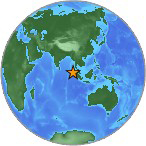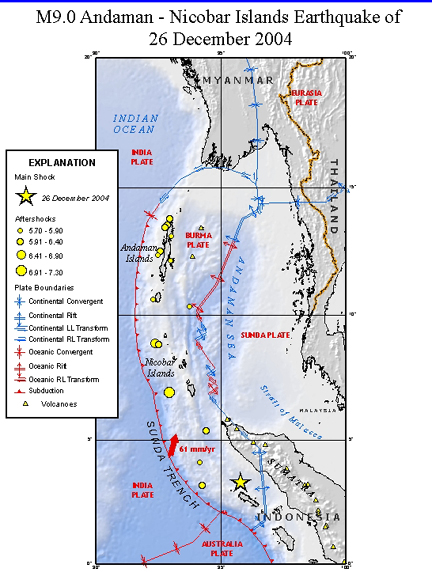Geotimes

Untitled Document

Web Extra
Monday, December 27, 2004 updated
Jan. 3 at 4:00 p.m. EST
Devastation in the Indian Ocean
 A magnitude-9.0
earthquake struck off the west coast of Northern Sumatra, Indonesia, on Sunday
morning at 6:58 a.m. local time. The giant temblor devastated the Indonesian
province of Aceh, and created destructive tsunami waves that crashed onto faraway
beaches in Sri Lanka, Thailand, India and other countries. So far, news agencies
are reporting at least 140,000 dead and thousands still missing, mostly from
the tsunamis.
A magnitude-9.0
earthquake struck off the west coast of Northern Sumatra, Indonesia, on Sunday
morning at 6:58 a.m. local time. The giant temblor devastated the Indonesian
province of Aceh, and created destructive tsunami waves that crashed onto faraway
beaches in Sri Lanka, Thailand, India and other countries. So far, news agencies
are reporting at least 140,000 dead and thousands still missing, mostly from
the tsunamis.
A magnitude-9.0 earthquake struck off
the coast of Sumatra, Indonesia, on Sunday morning, followed by dozens of powerful
aftershocks and large tsunami waves that reached as far as the east coast of
Africa, some 4,800 kilometers away. The tsunami waves caused the most damage,
including more than 140,000 people dead in 10 different countries. Image courtesy
of the U.S. Geological Survey.
 The
temblor itself was felt widely on Sumatra, where more than 94,000 people have
been killed, and buildings and towns have been leveled. The quake, only 10 kilometers
below the ocean, knocked out communication to the Aceh province, where reports
suggested that the initial quake and ensuing tsunamis killed at least 30,000
people in the capital city of Banda Aceh, according to MSNBC.
Another Indonesian town on Sumatra, Meulaboh, is reporting 40,000 people killed,
of its 120,000 residents. Communication and relief efforts are hampered there
by an ongoing rebel insurgency, in addition to treacherous terrain. Officials
surveying the area said the devastation is much worse than previously thought,
according to MSNBC reports.
The
temblor itself was felt widely on Sumatra, where more than 94,000 people have
been killed, and buildings and towns have been leveled. The quake, only 10 kilometers
below the ocean, knocked out communication to the Aceh province, where reports
suggested that the initial quake and ensuing tsunamis killed at least 30,000
people in the capital city of Banda Aceh, according to MSNBC.
Another Indonesian town on Sumatra, Meulaboh, is reporting 40,000 people killed,
of its 120,000 residents. Communication and relief efforts are hampered there
by an ongoing rebel insurgency, in addition to treacherous terrain. Officials
surveying the area said the devastation is much worse than previously thought,
according to MSNBC reports.
The earthquake occurred on the interface of the India and Burma plates, which
is in one of the most tectonically complex regions in the world, according to
the U.S. Geological Survey (USGS). The India plate is plunging
underneath the Burma plate, creating a so-called megathrust fault at the plates'
boundaries. The quake and its aftershocks were distributed along much of that
fault, with a total movement of about 1,000 kilometers (about 600 miles).
Aftershocks will continue for at least several months, and maybe even up to
a year after the earthquake, says Stuart Sipkin, a seismologist at the USGS
National Earthquake Information Center in Denver. Because of the huge magnitude
of the mainshock, the aftershocks will also start out big but will decrease
slowly in magnitude.
Powerful aftershocks rocked the interface
between the Burma and India plates. Several measured above magnitude 6.0, and
one was a magnitude 7.3. The remote Andaman and Nicobar islands marked the epicenters
of many of these aftershocks. Image courtesy of USGS.
This earthquake is one of the largest recorded in the past century, and the
largest to occur worldwide in the past 40 years (see sidebar).
Several of these earthquakes — all greater than magnitude 9.0 — triggered
tsunamis, which are an expected result from huge underwater earthquakes such
as the one that occurred Sunday. And while U.S. authorities are aware of the
risk and NOAA tracks tsunami waves in the Pacific, no tsunami warning system
is in place in the Indian Ocean region to notify of impending waves.
The quake and its dozens of very powerful aftershocks triggered tsunamis reportedly
up to 14 meters high (40 feet), traveling at speeds of several hundred miles
per hour. The waves hit the coasts of Sri Lanka, India, Indonesia, Thailand,
Malaysia, Somalia, Bangladesh, Maldives and Cocos Islands, sometimes moving
up to a kilometer inland. Somalia is more than 4,800 kilometers from the earthquake's
epicenter.
Authorities in Sri Lanka declared a state of emergency, reporting more than
30,000 people dead, thousands still missing and at least 1 million people displaced
or homeless. The country has launched its military on relief and rescue missions,
and India has sent warships filled with relief supplies. Flooding and land instability
are hindering rescue and relief efforts, as are landmines (remnants of a long
civil war in the country) that were uprooted by the tsunamis and are causing
additional rescue difficulties and deaths, as reported by CNN.
|
The last 100 years
The world's largest recorded earthquakes are all megathrust events occurring
at subduction zones. This magnitude-9.0 quake is the largest in 40 years,
since the Good Friday earthquake in Prince William Sound in Alaska in
1964. It is the fourth largest in the last century, following only a 9.0
in Kamchatka in 1952, a 9.1 in Alaska in 1957, the 9.2 Prince William
Sound quake, and the largest ever recorded, a magnitude-9.5 earthquake
in Chile in 1960, according to the U.S. Geological Survey. All five events
are megathrust quakes at subduction zones.
|
India is reporting nearly 9,500 dead, mostly along the southern coast where
several entire villages were swept away, and in the islands of Andaman and Nicobar,
where dozens of aftershocks were centered (many of which were over magnitude
6.0, with one at magnitude 7.3). Communication has been entirely cut off by
the disaster and thousands of fishermen from India's coastal cities have not
been accounted for yet.
In neighboring Thailand, hundreds of people are missing and close to 5,000
have already been confirmed dead following 9-meter-high tsunamis crashing ashore.
Nearly half of the dead are tourists. The Maldives Islands, a popular scuba-diving
destination, are reporting 80 dead and more missing, including a number of scuba
divers, according to CNN reports. The Washington Post reports dozens
of deaths in Malaysia, Myanmar (formerly known as Burma), Somalia, Bangladesh
and Kenya from floodwaters, with many more unaccounted for. It will likely take
days to weeks before exact death tolls are known, as many remote provinces in
these nations have not even been reached by rescuers or inspectors yet.
Countries around the world have sent or pledged aid, ranging from money, food
and first aid equipment to a floating hospital and a water purification plant.
The United Nations and the International Committee of the Red Cross are leading
relief efforts.
Compiled by Megan Sever
Links:
U.S.
Geological Survey National Earthquake Information Center
MSNBC
news coverage
CNN
news coverage
Washington
Post coverage
Associated
Press coverage on Yahoo.com
Back to top
Untitled Document

 A magnitude-9.0
earthquake struck off the west coast of Northern Sumatra, Indonesia, on Sunday
morning at 6:58 a.m. local time. The giant temblor devastated the Indonesian
province of Aceh, and created destructive tsunami waves that crashed onto faraway
beaches in Sri Lanka, Thailand, India and other countries. So far, news agencies
are reporting at least 140,000 dead and thousands still missing, mostly from
the tsunamis.
A magnitude-9.0
earthquake struck off the west coast of Northern Sumatra, Indonesia, on Sunday
morning at 6:58 a.m. local time. The giant temblor devastated the Indonesian
province of Aceh, and created destructive tsunami waves that crashed onto faraway
beaches in Sri Lanka, Thailand, India and other countries. So far, news agencies
are reporting at least 140,000 dead and thousands still missing, mostly from
the tsunamis.
 The
temblor itself was felt widely on Sumatra, where more than 94,000 people have
been killed, and buildings and towns have been leveled. The quake, only 10 kilometers
below the ocean, knocked out communication to the Aceh province, where reports
suggested that the initial quake and ensuing tsunamis killed at least 30,000
people in the capital city of Banda Aceh, according to
The
temblor itself was felt widely on Sumatra, where more than 94,000 people have
been killed, and buildings and towns have been leveled. The quake, only 10 kilometers
below the ocean, knocked out communication to the Aceh province, where reports
suggested that the initial quake and ensuing tsunamis killed at least 30,000
people in the capital city of Banda Aceh, according to 